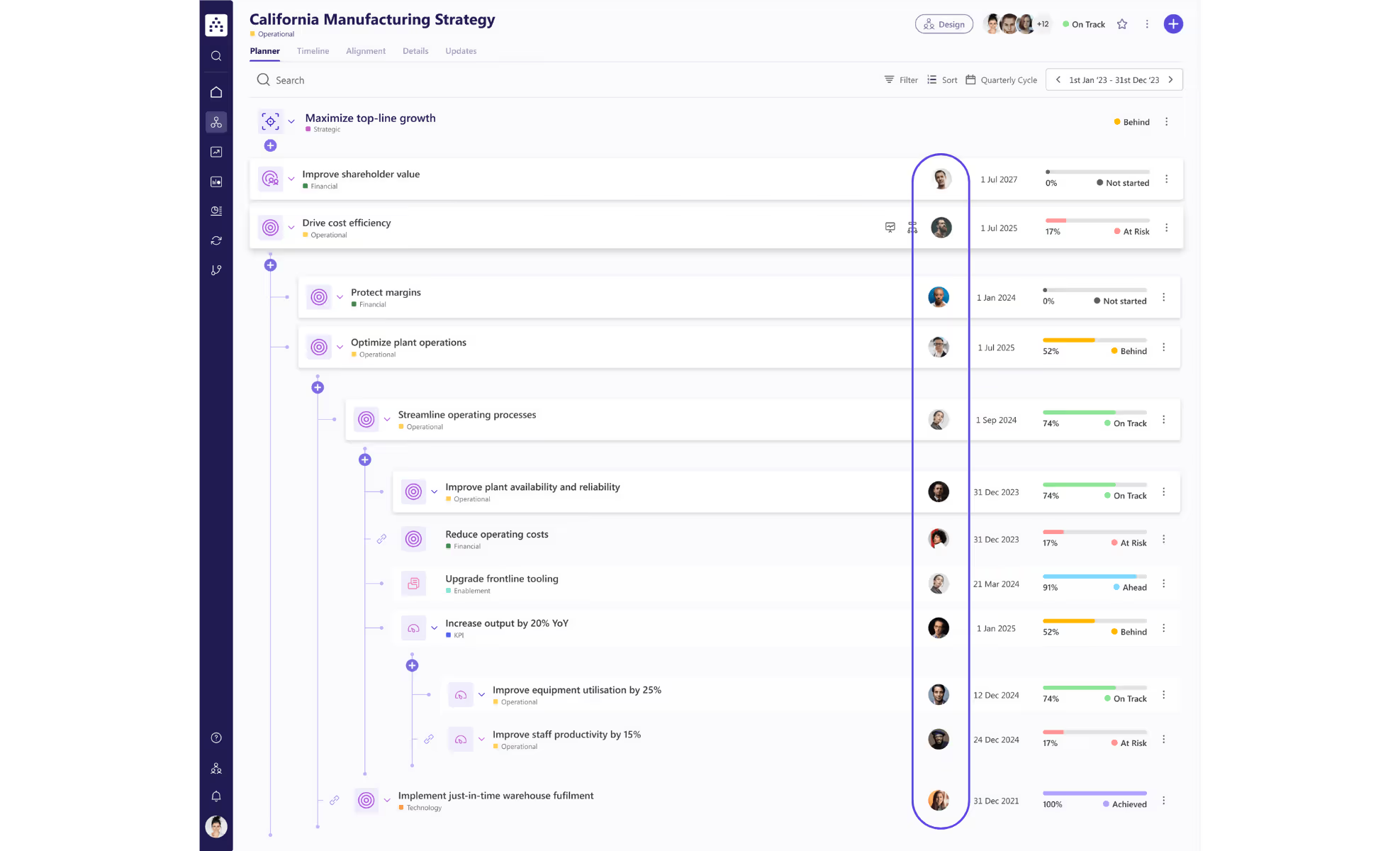Digital transformation roadmap overview
Global spending on digital transformation is expected to reach $3.4 trillion by 2026 after topping $1.6 trillion in 2022. However, this significant financial commitment doesn't necessarily equate to success.
The complex nature of digital transformation often results in less-than-ideal outcomes, as evidenced by a mere 16% of surveyed organizations reporting successful implementation. This issue isn't confined to traditionally less tech-oriented sectors; even the most digitally adept industries struggle, boasting success rates of only up to 26%.
Why? Because they don’t have an effective digital transformation roadmap and the right tools to maintain execution momentum across the organization.
Here’s what you will learn in this article:
- What Is A Digital Transformation?
- What Is A Digital Transformation Roadmap?
- Why Do You Need A Digital Transformation Roadmap?
- How To Build It In 11 Super Easy Steps
- 5 Common Challenges To Avoid In Your Digital Transformation Roadmap
- 5 Examples Of Successful Digital Transformation
So, let's get things straight before your team dumps the company’s entire corporate strategy resources into a burning barrel in the parking lot.
What Is Digital Transformation?
Digital transformation is the adoption of new technologies, tools, and modern practices into every aspect of an organization. As you overhaul how you do business, right down to how your people think, you transform your organization to be more successful in the digital age.
Many companies think they must ditch everything they’ve ever known. In reality, this evolution of your business is more about re-orienting your organization's strategies to make sure you get the most value from your resources.
And there’s no better way to guarantee success than with a digital transformation roadmap.
👉 Execute your digital transformation in Cascade! The #1 Digital Transformation Platform.
What Is A Digital Transformation Roadmap?
A digital transformation roadmap is a defined process that explains how an organization can embrace digital technology to achieve its business goals and ultimately become a more sustainable, future-proof business.
Your roadmap is an essential—but separate—aspect of your digital transformation strategy. Whereas a strategy is a blueprint that creates a clear vision of where you want to be in the future and why, the roadmap is a visualization of your strategy. It defines all activities you will need to complete within a given timeframe to achieve your goals.
Why Do You Need A Digital Transformation Roadmap?
Many companies have a strategy. Sure, it might be stuffed away in an old Dropbox folder somewhere, but it exists (somewhere). At least you’ll always have faint memories of that big presentation, right?
In truth, it’s the roadmap that really makes the difference—that’s where you detail how you will take ideas to implementation. Without a plan, your project relies on hope (and that’s never a good place to be in business!)
Here are three benefits of a digital transformation roadmap:
- Clarity: It's one thing to have an idea, and it's another thing to implement. A roadmap makes it crystal clear for your people to know exactly what to do, when, and how. That way, your organizational goals remain within reach.
- Inclusivity: No one wants to feel left out. When you only have a handful of decision-makers in the boardroom directing everyone else, it causes friction. Bring your team together by ensuring everyone has a say, and everyone knows the value and purpose of their role.
- Effectiveness: Using a roadmap is the most effective way to help people prioritize their daily actions. With a clear plan, your business can stay on track to your ideal destination, with the fewest number of detours in between.
Let’s imagine you want to build a house. You’ve got a general idea of what you want it to look like. It’s a two-story home with four bedrooms, five and three-quarter bathrooms, a kitchen, a pool, and a partridge and pear tree.
Great. That's the plan. Let's get started.
Wow, big fella. Not so fast.
The problem with a bare-bones strategy is that a simple list of goals doesn’t include the context you need to guide decision-making. People can see what you want, but they don’t know how they’re supposed to make it a reality.
Without clarity and direction, your project can quickly go off the rails.
11 Steps to Build A Digital Transformation Roadmap
Okay, so you want to make this change happen. It's time to create your digital transformation roadmap. Let's walk you through the process by considering one of the most extraordinary transformations in history. That's right. We're talking about Walter White becoming the bad guy in Breaking Bad.
1. Assess the current state of your business
A journey of a thousand miles begins with a single step. The first step towards a successful digital transformation is to know where you are. There are many techniques to assess your business’s current state, and you can take your pick from SWOT, PEST, or PESTLE analysis.
SWOT analysis looks at your organization’s Strengths, Weaknesses, Opportunities, and Threats, while PEST and PESTLE analysis focuses more on external factors. PEST helps you measure political, social, economic, environmental, and technological factors, while PESTLE includes legal and ethical factors in the equation.
Including these strategic analyses in your digital transformation process will help you create a comprehensive roadmap that considers your current state and positions your company to better take advantage of existing opportunities. It also makes your organization’s digital capabilities clearer.
💡Tip: Don’t fall into the trap of paralysis by analysis. If your diagnostic phase drags on for too long, the circumstances may shift before you spring into action.
2. Define your vision, mission, and values
Before you can set off on your digital transformation journey, you need to get clear on the destination. Plot your course with a defined company vision and values. What does the big picture look like? How do you want to achieve it? If you already have a clear vision, ensure you’re taking it into account when planning your digital transformation journey, and skip to the next step.

A vision statement lays the foundation for your business strategy. Make sure that it’s on top of everyone’s mind with Cascade.
When Walter White realized he needed to make bank before popping his clogs, he had a vision. Sure, his goal of becoming the crystal meth kingpin of Albuquerque isn't something that we recommend, but that grit and focus helped encourage his associates to work with him.
3. Unite your people with a clear plan
To create a digital transformation plan that actually leads people to the promised land, you need company-wide buy-in. That means everyone from your C-suite to the janitor’s break room has to be on board. How can you do that?
- Share information with everyone
- Listen to concerns and questions
- Take note of employee feedback
As you maintain open communication throughout the ranks, you can foster a close-knit culture that fuels happier employees and more productive action.
When it comes to senior management, the way to get them on board is to relate your digital transformation strategies with the overall company goals and vision. Present the benefits of your digital initiatives in terms of the ROI they will bring to the organization.
Contrary to Walter’s authoritarian approach, we recommend you present your vision in a way that is more inclusive and welcoming, as that will help unite your team. After all, people must support you before they can support your ideas. Likewise, when you get senior management to commit to your digital transformation process, you’d be 2.5 times more likely to succeed.
Legendary management genius, Peter Drucker, hit the nail on the head when he said that “culture eats strategy for breakfast.” Strategy is vitally important. But if your organizational culture isn’t aligned with what you want to achieve, it doesn’t matter how good your strategy is—your people won’t make it happen.
4. Set Key Performance Indicators (KPIs)
Whether you’re in the business of NFTs, non-profit, or narcotics distribution, you should set targets and measure performance. How else can you gauge progress and be sure you’re on track to your goals?
The best way to set KPIs is to use the SMART criteria framework:
- Specific. Avoid a vague goal—be specific about the desired outcome. For example, Walter White knew he needed $737,000 to provide for his family after he was gone.
- Measurable. From cash to conversions, pick a metric that makes sense and is easy to track over time.
- Achievable. Walter figured out it would take 11 more dodgy deals. Make sure you set something your team can deliver.
- Relevant. Don’t track KPIs that aren’t related to your goals or vision. Just as Walter turned a blind eye to the mounting body count, you shouldn’t worry about missing office pens. Just keep your eyes on the prize.
- Time-based. Everything should have a deadline. Whether it’s a terminal diagnosis or a big product launch that lights a fire under your collective rear ends, align your KPIs with a timeline that makes sense.
.png)
Create real-time visualizations and automated reporting of your KPIs within Cascade.
5. Start small and land some quick wins
The best way to get the ball rolling in your implementation plan is to land quick wins. Employees get excited when they know that their current actions drive digital transformation. Even small accomplishments can boost morale and motivate them to continue working toward successful digital adoption.
Start with easy-to-deploy and less complex projects, then gradually build up from there. Focus on initiatives that achieve a faster ROI and positive feedback loop. This will build your team’s confidence in their abilities to impact business results.
6. Nurture a transformation-ready culture
Company culture is vital to any transformation initiative. However, it goes beyond accepting current digital technologies. Because digital transformation is a rapid and constantly evolving process, the organizational culture must take a step higher and be one that continuously embraces change.
Digital technologies change all the time, and what works a few years back may be obsolete in the near future. An organization that is constantly ready to adapt to changes will be vital in keeping your company ahead of the game.
Your team must always see the value in adopting new processes and take a collaborative approach to change management. Encourage them to voice out concerns and share ideas to make things better. Address any hesitations early on and get them involved in planning your digital strategy roadmap.
7. Break it down and map your resources accordingly
On your digital transformation roadmap, you should break the process down into a series of mini-projects. You can then assign resources to each project and think about how best to optimize your use of time, money, and people at each step.
8. Establish accountability
Digital transformation will thrive upon the shoulders of motivated key stakeholders who believe in what you're trying to achieve and their role within the cause. You can create these champions in your organization by giving employees ownership of specific missions or digital transformation initiatives.

Make sure your employees are aware of their responsibilities within Cascade.
Engaged employees understand how their work impacts the bigger picture and connects to the company's vision. And there is no better way to keep people engaged and improve work performance than to empower them with responsibility. When Walter entrusted Jesse to take on a more significant role in the cooking, it kept his reluctant protege onside to grow the business (and keep Walter out of prison).
9. Perform analysis and feedback
Your team’s efforts need to be evaluated as they carry your ideas to implementation and throughout the course of the transformation. It's essential to maintain an ongoing loop of feedback and analysis. Continually ask:
- How successful are we?
- What impacts are we noticing on our internal stakeholders?
- What are the observable external outcomes?
Regardless of whether you have achieved the desired position as a market leader or not, it's essential to remember that success is not a one-time event. If there’s lingering dissatisfaction among your stakeholders—remember, buy-in is crucial.
Make it a habit to consistently solicit feedback, fine-tuning your business processes and practices along the way. This practice of continuous reflection and adjustment ensures that your transformation efforts remain resilient and sustainable.
10. Celebrate the little wins
As mentioned, digital transformation can be a long road. When you’re lost in the desert with no gas, you could lose sight of your vision. Without excitement, you only have hard work, which can dent morale and motivation.
It’s crucial to take note of the micro goals and achievements in the journey, as these moments can encourage people to dig deep when the going gets tough. Whether you just hit a new monthly revenue record or completed a 4-day “cookathon” that could net you millions in illicit narcotics sales, celebrating the milestones matter.
11. Ride the momentum
Digital transformation is not a set-and-forget process. It's an evolution of your business and the springboard to embrace new ideas, technologies, and practices.
Your digital transformation roadmap will help you plot the course, define the actions and mini-projects, and tackle challenges along the way. Moreover, it will give you momentum to drive game-changing innovation as you move forward to the next stage.
You might find that your goals and end vision shift over the journey. You might set your sights on bigger ambitions, from simply having a sustainable business to building what Walter calls “the empire business.”
📚Recommended read:Why Business Transformation Fails: Learn From An Expert
Best Practices For Following Your Digital Transformation Roadmap
To get your digital transformation strategy up and running, follow these best practices.
Align digital transformation with customer needs
There's one cardinal rule in digital transformation: always keep your customers at the center. Your digital strategy roadmap should be guided by their needs, desires, and pain points. After all, there's no point in transforming if you're not delivering what your customers need.
Start by gathering and analyzing customer data on how they interact with your business. Create a comprehensive picture of your customer profile so you can better address their challenges and ensure the success of your digital transformation strategies.
Enlist transformation advocates
These are the tech-savvy trailblazers within your organization who embrace change with open arms—your very own “early adopters”.
Enlist these change champions and empower them to spread the word. Choose individuals who are highly respected among their peers and equip them with the right communication strategy. Their enthusiasm and knowledge will inspire others to hop on board the digital bandwagon.
Aim for a fast start
Slow and steady may win the race, but fast and furious wins hearts and minds. Break down your transformation journey into smaller, achievable milestones. This way, you can build momentum, celebrate quick wins, and keep the excitement alive. Remember, a swift start sets the tone for the rest of the race and ensures you don't get left in the dust.
However, guard your team against complacency because of these early achievements. To keep the momentum going, reinvest in the early results to drive the value of your transformation higher. You can turn early adopters into vocal advocates who will help late bloomers adapt to the new technologies.
Prioritize team communication
Communication is the fuel that keeps the engine running smoothly. Make sure everyone understands the goals, timelines, and expectations.
Create a collaborative environment where ideas flow freely, and feedback is embraced with open arms. This way, you can avoid any miscommunications or wrong turns that might throw you off course.
Adopt an agile mindset
In the roadmap for digital transformation, flexibility is the name of the game. Things change faster than you can say, "update available." To stay ahead of the curve, it's essential to adopt an agile mindset.
Embrace change as an opportunity for growth, not a roadblock. Be ready to pivot, adapt, and iterate your plans based on new information and emerging trends. In this fast-paced digital race, only the nimble survive.
Use the right technology
Navigating digital transformation isn't just about managing the minutiae—it's about having a bird's eye view of your whole operation. Sure, spreadsheets and project management tools are great for the nitty-gritty, but when it comes to the big picture, you'll want a strategy execution platform such as Cascade in your digital toolkit.
Cascade helps you connect the dots between day-to-day operations and overarching transformation strategy. It provides real-time progress updates, seamless alignment across your entire organization, and the ability to foresee risks. With Cascade, you're not just navigating the digital transformation—you're mastering it.
5 Common Challenges To Avoid In Your Digital Transformation Roadmap
If you want to survive any journey, you must avoid the pitfalls. Here are five challenges to be aware of when you create your roadmap:
1. Lack of collaboration
When you lack team alignment, it doesn’t matter how amazing your business strategy seems on the surface. The people responsible for on-the-ground execution must share your vision, and they must embrace open communication and collaboration. Walter’s undoing was rooted in an inability to get everyone in line.
2. Lack of specificity
Failure to be specific on the details leaves things open to chance. People might run with their initiative, but if this is misguided, you could be left with a mess (like if you fail to mention budget limits on a paid advertising campaign or why someone shouldn’t pour hydrofluoric acid into a bath). In your digital transformation roadmap, you must set clear directions to your final destination—the details matter.
3. Lack of monitoring
Another trap that many companies fall into is that they forget (or neglect) their monitoring duties. You can decide how often you analyze the progress on your goals and how often you compile reports. Maybe it's weekly, perhaps it's monthly. Just make sure you set your KPIs and track progress over time. If you don't, you could waste a lot of time, effort, and money.
.png)
Monitor your progress in real-time with personalized and automated reports within Cascade.
4. Lack of risk management
Every company must know what risks lie ahead. Simply putting your head down and hoping for the best isn't a strategy that will get you across the finish line. You might dodge a few bullets, but eventually, the lack of forward-planning will catch up with you. Think about everything that could threaten your progress or prevent you from making your transformation—internally and externally.
5. Lack of the right tools
It’s not easy to manage customer expectations, new products, and new workflows, let alone do it all while your team embraces a new way to do everything. When you have the right tools, it’s easier to make every day count as a bigger step toward the organizational goals.
Cascade simplifies strategy execution by connecting all projects and KPIs in one place. It helps your entire team collaborate across your digital transformation initiatives to carry out your strategic priorities in an effective way.
5 Examples Of Successful Digital Transformation
Successful digital transformations require significant cultural change. You might have the aim of greater strategic alignment, a competitive advantage, or it could be a complete redefinition of your customer journey.
Here are some great examples of companies that must have an excellent digital transformation roadmap:
UPS
The global courier company could see the importance of delivery speed and data analytics in the modern age. Not waiting around for an emerging startup to usurp them, UPS was able to pre-empt disruption.

Its focus on artificial intelligence, automation, and big data analytics led to real-time package tracking. Ultimately, this innovation paved the way for a better supply chain, quicker delivery times, and a better customer experience.
IKEA
Furniture is something most people want to shop for in person. Still, IKEA didn’t let that stop them from going gung-ho with digital transformation.
The Swedish furniture giant used fun branding on its website to connect with its audience and tapped into augmented reality to provide a more immersive, interactive shopping experience. Customers can visualize items in their homes through the app or use their smartphones to scan items while they shop to speed up the checkout process.

Nike
If you want to be a high-impact brand, you need to make high-impact changes. For many years, Nike has invested heavily in its digital ecosystem to help engage employees and customers alike.

A focus on lean manufacturing techniques and digital strategy helped Nike remain profitable and competitive in 2021 and beyond, despite supply chain issues during the pandemic. It’s just the latest chapter in one of the most innovative brands in history—you can learn more by checking out our case study in the Strategy Factory.
Disney
Digital transformation involves reinventing how customers experience your brand. Disney accomplished this by launching Disney+, their digital streaming platform, instead of just licensing content to competitors like Netflix.

To elevate things further, Disney also created MyMagic+, a wristband that uses RFID technology to enable park visitors to pay for services such as rides and hotels. The data collected in these wristbands allows Disney to provide personalized experiences for each of its millions of visitors, creating a truly omnichannel experience that puts the brand at the forefront of digital transformation.
Adobe
When Adobe realized the need to pivot to a SaaS business model, they were met with resistance and declining sales from investors and existing customers.

As the digital landscape evolved, standalone licensed products became less relevant. To survive, Adobe had to adapt. With the launch of its Adobe Creative Cloud, the company pivoted to the subscription-based model, like fellow software giant Microsoft. The change proved successful as the company continued to grow its revenue due to Creative Cloud. It was a long journey that took guts, patience, and clear focus to achieve success.
Transformation Takes Time
Digital transformation isn't a sprint, and it isn't even a marathon—it's an epic adventure that could last years. If you don’t have a solid strategy that explains what you want to achieve, how to do it, and who will be responsible, there’s no chance of success.
Clarity, context, and step-by-step directions are just the basics. A proactive attitude to KPIs, analysis, feedback, and iteration are critical elements to ensure you don't get stuck.
With a digital transformation roadmap, you can lay the entire strategy out in an intuitive way that makes it easy for your entire team to get on board and stay on track.
Build Your Digital Transformation Roadmap In Cascade 🚀
You have the power to make large-scale transformation possible. Where most transformation programs fail, make yours part of the few that succeed. With strategy execution software like Cascade, you can stay on course during the long journey ahead and remain adaptive to fluctuating market demand and conditions.
Develop clear plans for your team and monitor quick wins by setting strategic milestones. Establish clear accountability and cultivate a collaborative environment that drives strategy execution momentum. Break down data silos and get full visibility into what’s happening.
With Cascade’s digital transformation template, you can adapt as quickly as the world shifts around you.
Get started for free today or book a 1:1 demo with Cascade’s in-house strategy expert.






.png)
.jpg)
.jpg)
%20(1)%20(1)%20(1)%20(1)%20(1).png)



